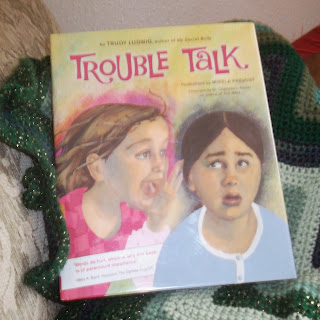 |
 |
Two very different portrayals of bullying emerge in Goggles!, written and illustrated by Ezra Jack Keats (1969) and in Trouble Talk, written by Trudy Ludwig and illustrated by Mikela Prevost (2008).
In Googles!, a 1970 Caldecott Honor Book, a young boy named Peter and his friend Archie find a pair of motorcycle goggles. When older boys try to take the goggles, they hide from them and trick them in order to escape.
In Trouble Talk, a young girl, Bailey, engages in “relational aggression.” She says hurtful things and spreads rumors about classmates to gain power and status. The narrator, Maya, watches a friend get blamed for something she didn’t do on the basis of Bailey’s rumors and later becomes the target of a rumor campaign herself.
The biggest difference in these two books is the approach taken by the authors and the role played by adults.
Keats presents what reads as a single episode in what could be an ongoing conflict. Adults are completely absent from the story.
I wondered after reading Goggles!, what would happen when Peter and Archie next encountered that group of bullies. Similarly, I wondered about the attitudes toward bullying of adults in these children’s lives. Was anyone willing to intervene on Peter and Archie’s behalf? Or, if they were aware at all, did they take a “kids-will-be-kids” attitude?
The Ezra Jack Keats Foundation provides a lesson plan about bullying, but having the issue remain unresolved in the story really frustrated me, both as a reader and as a survivor of bullying.
In Trouble Talk, by comparison, a foreword by Charisse L. Nixon, Ph.D, director of research for The Ophelia Project, talks about ways that girls are socialized to engage in relational aggression. Nixon emphasizes that the role of adults is “to teach boys and girls how to develop healthy, intimate relationships without sharing information that is not theirs to share,” and that the purpose of the book is to provide “real strategies” for young readers to deal with “everyday friendship issues” like “how to fit in, whom to trust, and how to make friends.”
When telling the story, Ludwig sees the conflict through to a resolution. Adults play an active role.
The narrator, Maya, has an opportunity to talk with the school counselor, who explains that Bailey has what sounds to be “a bad case of trouble talk.” The counselor promises that she will work with Bailey and will speak to the rest of the students about not spreading rumors. At the end of the book, while Maya is not ready to trust Bailey as a friend, Bailey is portrayed as trying to make amends for the harm she caused.
Ludwig also addresses bullying in two earlier books: My Secret Bully in 2004 (illustrated by Abigail Marble) and Just Kidding in 2006 (illustrated by Adam Gustavson). Her website lists additional titles that I hope to read as well.
Composed for Cuesta College’s ECE 234, Children’s Literature
No comments:
Post a Comment
Robust debate and even unusual opinions are encouraged, but please stay on-topic and be respectful. Comments are subject to review for personal attacks or insults, discriminatory statements, hyperlinks not directly related to the discussion and commercial spam.